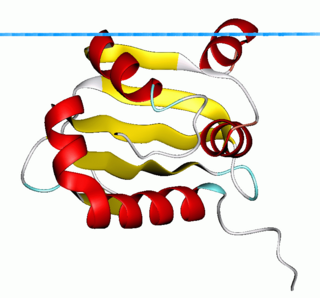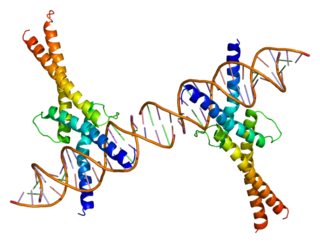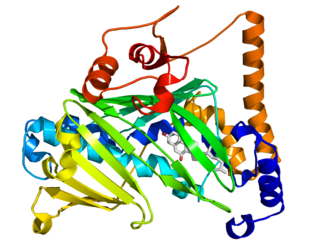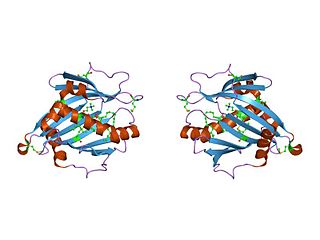
Peripheral membrane proteins, or extrinsic membrane proteins, are membrane proteins that adhere only temporarily to the biological membrane with which they are associated. These proteins attach to integral membrane proteins, or penetrate the peripheral regions of the lipid bilayer. The regulatory protein subunits of many ion channels and transmembrane receptors, for example, may be defined as peripheral membrane proteins. In contrast to integral membrane proteins, peripheral membrane proteins tend to collect in the water-soluble component, or fraction, of all the proteins extracted during a protein purification procedure. Proteins with GPI anchors are an exception to this rule and can have purification properties similar to those of integral membrane proteins.

Sterol regulatory element-binding proteins (SREBPs) are transcription factors that bind to the sterol regulatory element DNA sequence TCACNCCAC. Mammalian SREBPs are encoded by the genes SREBF1 and SREBF2. SREBPs belong to the basic-helix-loop-helix leucine zipper class of transcription factors. Unactivated SREBPs are attached to the nuclear envelope and endoplasmic reticulum membranes. In cells with low levels of sterols, SREBPs are cleaved to a water-soluble N-terminal domain that is translocated to the nucleus. These activated SREBPs then bind to specific sterol regulatory element DNA sequences, thus upregulating the synthesis of enzymes involved in sterol biosynthesis. Sterols in turn inhibit the cleavage of SREBPs and therefore synthesis of additional sterols is reduced through a negative feed back loop.
The steroidogenic acute regulatory protein, commonly referred to as StAR (STARD1), is a transport protein that regulates cholesterol transfer within the mitochondria, which is the rate-limiting step in the production of steroid hormones. It is primarily present in steroid-producing cells, including theca cells and luteal cells in the ovary, Leydig cells in the testis and cell types in the adrenal cortex.

The liver X receptor (LXR) is a member of the nuclear receptor family of transcription factors and is closely related to nuclear receptors such as the PPARs, FXR and RXR. Liver X receptors (LXRs) are important regulators of cholesterol, fatty acid, and glucose homeostasis. LXRs were earlier classified as orphan nuclear receptors, however, upon discovery of endogenous oxysterols as ligands they were subsequently deorphanized.

CRAL-TRIO domain is a protein structural domain that binds small lipophilic molecules. This domain is named after cellular retinaldehyde-binding protein (CRALBP) and TRIO guanine exchange factor.

Sterol carrier proteins is a family of proteins that transfer steroids and probably also phospholipids and gangliosides between cellular membranes.

Sterol regulatory element-binding transcription factor 1 (SREBF1) also known as sterol regulatory element-binding protein 1 (SREBP-1) is a protein that in humans is encoded by the SREBF1 gene.

Acyl-coenzyme A thioesterase 8 is an enzyme that in humans is encoded by the ACOT8 gene.

The oxysterol-binding protein (OSBP)-related proteins (ORPs) are a family of lipid transfer proteins (LTPs). Concretely, they constitute a family of sterol and phosphoinositide binding and transfer proteins in eukaryotes that are conserved from yeast to humans. They are lipid-binding proteins implicated in many cellular processes related with oxysterol, including signaling, vesicular trafficking, lipid metabolism, and nonvesicular sterol transport.

Oxysterol-binding protein 1 is a protein that in humans is encoded by the OSBP gene.

StAR-related lipid transfer protein 5 is a protein that in humans is encoded by the STARD5 gene. The protein is a 213 amino acids long, consisting almost entirely of a StAR-related transfer (START) domain. It is also part of the StarD4 subfamily of START domain proteins, sharing 34% sequence identity with STARD4.

Acyl-coenzyme A thioesterase 11 also known as StAR-related lipid transfer protein 14 (STARD14) is an enzyme that in humans is encoded by the ACOT11 gene. This gene encodes a protein with acyl-CoA thioesterase activity towards medium (C12) and long-chain (C18) fatty acyl-CoA substrates which relies on its StAR-related lipid transfer domain. Expression of a similar murine protein in brown adipose tissue is induced by cold exposure and repressed by warmth. Expression of the mouse protein has been associated with obesity, with higher expression found in obesity-resistant mice compared with obesity-prone mice. Alternative splicing results in two transcript variants encoding different isoforms.

StAR-related lipid transfer protein 10 (STARD10) or PCTP-like protein is a lipid transfer protein that in humans is encoded by the STARD10 gene. The protein derives its name from the fact that the molecule contains a START domain. As part of the StarD2 subfamily, StarD10 can transport the lipids phosphatidylcholine and phosphatidylethanolamine between membranes in solution. Casein kinase II phosphorylates the protein on its serine at position 184.

Phosphatidylcholine transfer protein (PCTP), also known as StAR-related lipid transfer domain protein 2 (STARD2), is a specific intracellular phospholipid binding protein that can transfer phosphatidylcholine between different membranes in the cytosol.

StAR-related lipid transfer domain protein 7 (STARD7) or gestational trophoblastic tumor gene-1 (GTT1) is a lipid transporter that specifically binds and transports phosphatidylcholine between membranes.

StAR-related lipid transfer protein 4 (STARD4) is a soluble protein involved in cholesterol transport. It can transfer up to 7 sterol molecules per minute between artificial membranes.

Acyl-CoA thioesterase 13 is a protein that in humans is encoded by the ACOT13 gene. This gene encodes a member of the thioesterase superfamily. In humans, the protein co-localizes with microtubules and is essential for sustained cell proliferation.

Acyl-CoA thioesterase 1 is a protein that in humans is encoded by the ACOT1 gene.

StAR related lipid transfer domain containing 3(STARD3) is a protein that in humans is encoded by the STARD3 gene. STARD3 also known as metastatic lymph node 64 protein (MLN64) is a late endosomal integral membrane protein involved in cholesterol transport. STARD3 creates membrane contact sites between the endoplasmic reticulum (ER) and late endosomes where it moves cholesterol.
VAD1 analog of StAR-related lipid transfer (VASt) is a steroidogenic acute regulatory protein‐related lipid transfer (StART)-like lipid-binding domain first identified in the vad1 protein in Arabidopsis thaliana. Proteins containing these domains are found in eukaryotes and usually contain another lipid-binding domain, typically the GRAM domain and sometimes the C2 domain in plants and the integral peroxisomal membrane peroxin Pex24p domain in oomycetes.

















